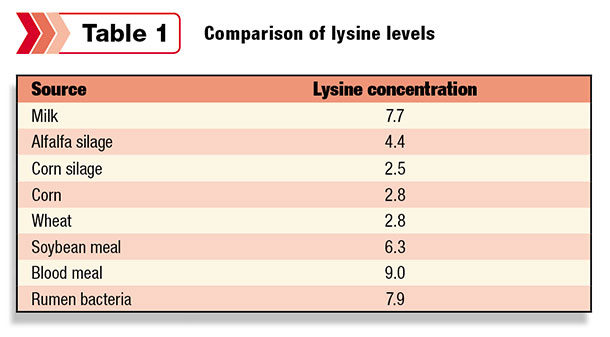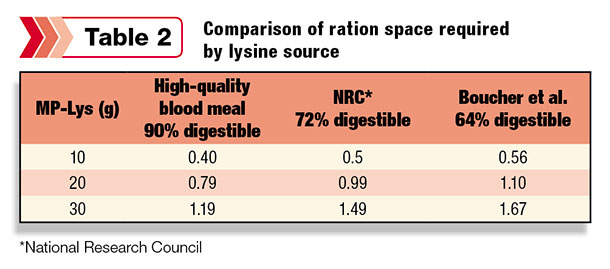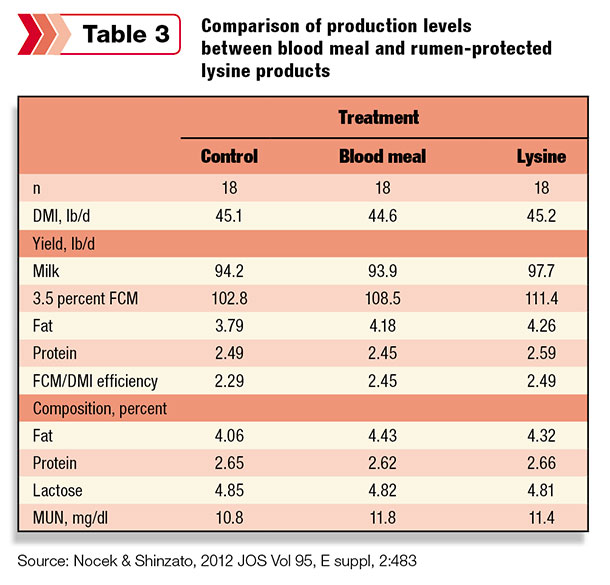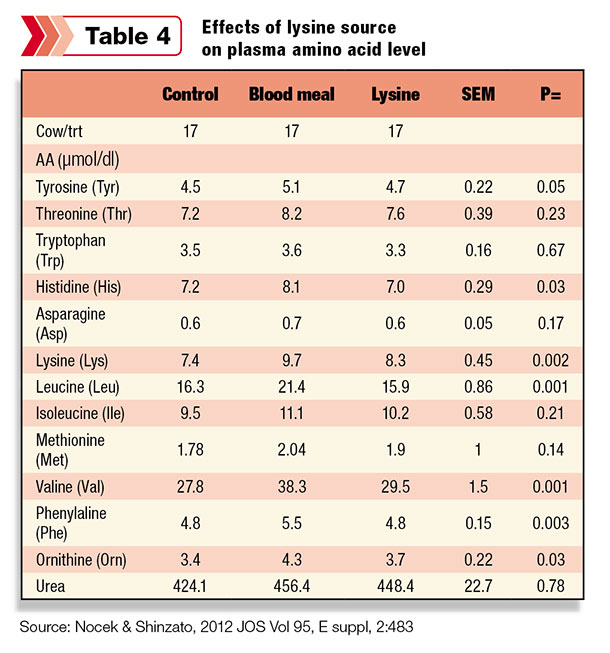Most dairy nutritionists report that they balance the amino acid levels in their dairy rations to bolster income over feed cost (IOFC). Typically, this includes the use of supplemental methionine and lysine, the first two limiting amino acids. They are limiting because, when in short supply, they can limit herd performance. Supplementation is required as they do not naturally occur in high enough levels in feedstuffs to meet dairy cow needs.
When using a supplemental lysine, the source matters: a rumen-protected lysine or blood meal. Blood meal may be used as a supplemental lysine when the price is low. Yet, even then, today’s rumen-protected lysine products often offer a better value.
Feeding blood meal is an age-old practice that may deliver excessive and wasted nutrients. Blood meal is closely associated with inconsistencies in digestibility (i.e., the lysine it contains may not be readily available).
In addition, the overfeeding of other amino acids can have negative consequences. Blood meal requires more ration space than today’s rumen-protected lysine products. Palatability can be another consideration.
Background
The practice of balancing the amino acid levels in the diet has been gaining recognition and use among producers for many years. On the income side, herds often realize increases in milk yield, milk protein and butterfat. On the cost side, crude protein levels can be reduced as much as 3 percent. This nicely reduces the investment in protein and makes space for other ration feedstuffs.
A stream of articles has been reporting and continues to report on the insights gained from industry and university professionals when balancing amino acids and using rumen-protected methionine and rumen-protected lysine. Making an optimal level of amino acids available to the cow is sound nutrition.
Nutritionists in the swine and poultry industries pioneered amino acid balancing and have been realizing the resulting production gains for decades. The better delivery of protein building blocks makes for more efficient protein synthesis.
The herd benefits. Protein is one of the most important nutrients in dairy cow diets. It is integral to immune system regulation as well as growth, reproduction, milk yield and milk component production.
Amino acid balancing also helps lessen a dairy’s environmental impact as less nitrogen is excreted.
Lysine
In addition to being a limiting amino acid, lysine cannot be produced by cows from other ration nutrients. This makes it an essential amino acid; in comparison, non-essential amino acids can be produced by the cow from ration nutrients and do not require supplementation. Lysine levels in feedstuffs, rumen bacteria and milk vary widely (Table 1).

Blood meal
Blood meal is high in lysine, but there is more to the story. Blood meal may actually reduce herd potential, according to insights researchers have gained over time.
The biggest challenge in feeding blood meal is its own inconsistency. Research conducted at the University of Minnesota and Ohio State University has shown that the digestibility of blood meal is variable and inconsistent.
The value for lysine digestibility is highly important as it shows how much of the lysine is available to the cow. The average percent digestibility in all the blood meals tested was around 65 percent, with a range of from 30 percent to nearly 100 percent. The National Research Council (NRC) gives a standard value of 72 percent digestibility to all blood meals.
Blood meals go through a drying process before being used in diets. The process can, and often does, damage the available nutrients, including lysine. This introduces inconsistencies to the blood meal’s nutritional profile.
Little variation among biological sources is expected. The proportion of blood proteins is consistent within a species, and only small differences occur between swine and cattle. The range makes it especially difficult to consistently balance rations for amino acids using blood meal.
Blood meal also presents other feeding issues. Supplementing with blood meal can result in the overfeeding of amino acids. The cow must then use energy to convert the unneeded amino acids into ammonia for excretion as urea, an environmental concern.
Blood meal also limits diet space. High-producing dairy cows are naturally limited on lysine due to rumen-fill issues that restrict intake. Feeding blood meal requires a significant amount of diet space. An example of this is shown in Table 2. To reach the needed amount of additional lysine from metabolizable protein (MP-Lys), it would take significantly more blood meal regardless of the research value used.

Supplementing with a consistent lysine source is an attractive option for increasing IOFC as the ration’s amino acid levels can be more precisely balanced. In addition, high-producing herds are achieving higher milk component concentrations, improved health and breeding. Amino acid balancing is increasingly a management tool for realizing the herd’s genetic potential.
Rumen-protected lysine
Today’s rumen-protected lysine products differ considerably from blood meal. For the most part, the lysine level these rumen-protected lysine products contain is highly consistent.
Typically, the use of rumen-protected lysine products increases the space in the ration for other feedstuffs. Many nutritionists will take this opportunity to feed more high-quality forage.

In a recent research trial comparing blood meal to a commercial lysine product, a significant difference existed in performance. When multiparous cows were tested between weeks 4 and 7 of lactation for milk yield, butterfat and milk protein, those receiving a rumen-protected lysine product performed significantly better than those receiving blood meal.
A comparison of blood plasma samples showed that the blood lysine level increased among cows receiving blood meal. This indicates that the blood meal did deliver a significant amount of lysine; however, many other amino acid levels also increased, which likely diminished the effects of the lysine being supplied.

Consider the source
Choices exist when formulating rations to bolster IOFC. Considerations include the proper use of amino acid balancing and which supplemental methionine and lysine sources to use. With the supplemental lysine, knowing the source matters. PD
Jessica Tekippe is the AjiPro-L rumen-protected lysine product manager for Ajinomoto Heartland Inc. She can be contacted by email.






